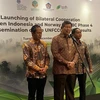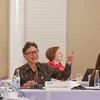 Singapore jumped from third place last year to first, switching places with the US, which slipped from top spot to third.(Source: straitstimes.com)
Singapore jumped from third place last year to first, switching places with the US, which slipped from top spot to third.(Source: straitstimes.com)Hanoi (VNA) – Singapore is the world’s leading competitive economy in 2019, according to the annual rankings announced by the International Institute for Management Development on May 29.
The Southeast Asian nation leapfrogged over Hong Kong and the US to take the top spot among the world’s most competitive economies for the first time in nine years.
The country rose to first place thanks to its modern technology and infrastructure, as well as highly qualified workforce.
Hong Kong maintained its position in second place from last year, thanks to its favorable tax policies.
The US dropped to third place, losing its leading position last year, due to high oil prices, low levels of high-tech goods exports, and fluctuations in the USD exchange rate.
Switzerland, the United Arab Emirates (UAE), the Netherlands, Ireland, Denmark, Sweden, and Qatar are also among the ranking’s top 10.
Among other Asian economies, Indonesia rose to the 32nd position, up 11 places from last year; while Thailand rose 5 places, to reach 25th place. Vietnam was not among the 63 economies included in the rankings.
The rankings were made based on a series of criteria including growth, unemployment rate, and spending on education and healthcare. –VNA
VNA






















